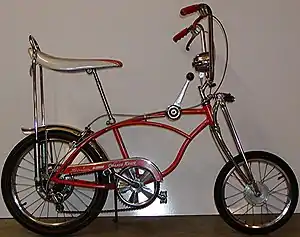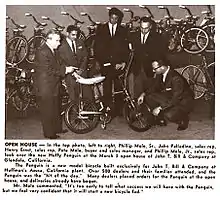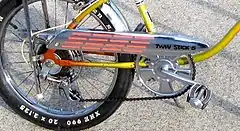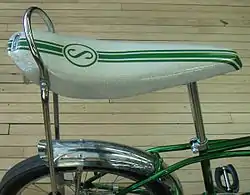Wheelie bike
A wheelie bike, also called a dragster, muscle bike, high-riser, spyder bike or banana bike, is a type of stylized children's bicycle designed in the 1960s to resemble a chopper motorcycle and characterized by ape hanger handlebars, a banana seat with sissy bar, and small (16-to-20-inch (410 to 510 mm)) wheels.[1][2][3] Notable examples include the Schwinn Sting-Ray and Krate lines and the Raleigh Chopper line. Other notable manufacturers and retailers that offered models include AMF, CCM, Columbia, Huffy, Iverson, J. C. Penney, Malvern Star, Monark, Murray, Ross, Sears, and Vindec.






In modern usage, "wheelie bike" can refer to a large-frame BMX bike.[4]
History
In 1962, Peter Mole of John T Bill & Co contacted Huffy Corp about making a new bicycle called High Rise. The bikes had a long seat called a banana seat with strut and taller handlebars. Huffy hesitated for several months before agreeing to make the bike with the stipulation that if it was a flop, Peter Mole would buy all the left-over parts and bikes. The new bike, called the Penguin, was finally being sold in stores by March 1963 and was the first of this type to market.[5][6][7] Also in 1963, Schwinn's designer Al Fritz heard about a new youth trend centered in California for retrofitting bicycles with the accoutrements of motorcycles customized in the Bobber or Chopper style.[8] Inspired, he designed a mass-production bike for the youth market as Project J-38, and the result was introduced to the public as the Schwinn Sting-Ray in 1963.[9] Sales were initially slow, but eventually took off. By 1965, several other American and foreign manufacturers were offering their own version of the Sting-Ray.
BMX bikes began to supersede wheelie bikes in the mid-1970s, though Schwinn continued to offer them until 1982 and Raleigh until 1984.[10] Original wheelie bikes are popular collectors' items now,[1][11] and some manufacturers have reintroduced updated versions.[10][12]
Features
The seating position nearly over the rear tire facilitated performing wheelies. Styling cues were also taken from muscle cars, and features included different sized wheels, with the smaller in the front, and square-profiled tires. Small, chromed fenders, a style borrowed from bobber motorcycles, were also popular.
- Handlebars
Besides the original ape hanger handlebars, several models sported ram horn style handlebars that contained loops.[13] Huffy even introduced a model, called The Wheel, with a steering wheel in place of handlebars.[14][15]
- Gears
Two-speed rear hubs, that the rider shifted by back pedalling, were common, but some featured external rear derailleurs with 3 or 5 gear ratios and automotive-like gear shifters mounted on the top tube.
- Brakes
Coaster brakes and rim brakes were common. The 1968 Schwinn Krate models had a front drum brake.[9] The 1972 Schwinn Pea Picker included a rear disc brake.[9]
- Forks
The 1968 Schwinn Krate models included a spring suspension front fork. At least one model, the Murray Kingkat, came from the factory with long forks resembling a chopper motorcycle.[16]
- Seating
Besides making wheelies easier,[1] the banana seats facilitated carrying passengers.[2]
Several manufacturers made tandem versions, including Schwinn,[17][18] Raleigh,[19][20] and Rollfast.[21]
Accessories
Many after-market accessories were available for muscle bikes including wheelie bars, drag chutes, "slick" tires, speedometers, windshields, hand grip streamers, headlights, taller sissy bars, axle spinners, and back rests.
Impact
The Raleigh Chopper was the best selling children's bicycle in the UK.[12] The wheelie bike fad drove bicycle sales to over 4 million units in the US,[2] and accounted for 75% of total US bicycle sales in 1968,[22] but it also helped contribute to the impression in the US that bicycles are merely children's toys.[1] Dangerous features, such as shifters mounted on the top tube, were banned in the US in 1974.[3][11] The wheelie bike fad even attracted the attention of non-bicycle manufacturers that developed and sold add-on products, such as the Wham-O wheelie bar.[23]
Though initially a US fad, wheelie bikes also became popular in the UK, Canada, New Zealand,[24] and South Africa.[25] Australia had its own Malvern Star Dragster,[26] Brazil had its own Monark Tigrão,[27] and in Norway, Øglænd made the DBS Tomahawk.
Dot Wiggin, formerly of The Shaggs, recorded the song "Banana Bike" in 2013 as a tribute to her sister Helen, who died in 2006. Helen owned a yellow imported Raleigh Chopper that she used to keep fit with, that Dot found amusing that a grown woman should be using a children's bike. Helen explained that it was far more comfortable for her than a normal bike.
Names
Part of the appeal of these bikes was their colorful and evocative names. Besides the Schwinn Sting-Ray and Raleigh Chopper, examples include:
|
References
- Brown, Sheldon. "Wheelie Bike". Sheldon Brown. Retrieved 2010-06-27.
Wheelie Bike. Also known as a "high-riser", "Stingray", "polo bike", "banana bike", "Chopper".
- Herlihy, David V. (2004). Bicycle, The History. Yale University Press. pp. 363. ISBN 0-300-10418-9.
Meanwhile, a new juvenile craze broke out and propelled domestic bicycle sales past the four million mark for the first time. This time around, the demand was for new-fangled "high-risers" like Schwinn's Sting-Ray.
- John Jurgensen (June 12, 2005). "Muscle Bike Still Spins Magic Spell. Cool Bicycle Spoke Volumes to Ageless Kids, Who Still Get a Kick from Wheelies, Burning Rubber". Hartford Courant. Retrieved 2010-06-30.
By today's standards, they are heavy, clumsy and laden with odd and dangerous accessories. But at a time when the Rolling Stones ruled the airwaves and helmets were unheard of, muscle bikes were the coolest things on two wheels.
- "Haro Bikes Wheelie Bikes". Haro Bikes. Retrieved 2022-08-05.
- John Brain. "The Birth of the Factory Muscle Bike: 1963".
John T. Bill introduced the Penguin to their many So-Cal dealers on March 3rd 1963, at the open house of their new corporate facilities in Glendale CA.
- William Hudson. "Myths and Milestones in Bicycle Evolution".
Leon Dixon of the National Bicycle History Archive of America notes: "This is a very serious myth. First, Schwinn merely copied the Huffy Penguin which existed BEFORE the Sting-Ray.
- "Evolution of the High Rise Bicycle 1963". Raleigh Ron's Classics. Retrieved 2012-01-16.
- Leon Dixon (2009). "How it Began". National Bicycle History Archive of America. Retrieved 2012-01-16.
It was the KIDS in Southern California who came up with different ways to fit out 20-inch bicycles that resulted in the Penguin, Sting-Ray and so-called musclebikes.
- Lou Dzierzak (2002). Schwinn. MBI Publishing Company. p. 41. ISBN 978-1-58068-003-5.
- "Schwinn Sting-Ray Mania Continues". Pacific Cycles. Retrieved 2010-07-01.
- "History: The Birth of the Original Sting-Ray". Pacific Cycles. Retrieved 2010-07-01.
- Kirby, Terry (2004-02-24). "The decade taste forgot is back - on a brand new Raleigh Chopper". London: The Independent. Retrieved 2010-06-27.
- John Brain's. "History of Kustom Biking Volume Two: The second five years, 1963-'67". Retrieved 2010-07-01.
- "Huffy's The Wheel (picture #1)". Archived from the original on 2012-03-23. Retrieved 2010-07-01.
- "Huffy's The Wheel (picture #2)". Archived from the original on 2012-04-05. Retrieved 2010-07-01.
- "Murray Kingkat". New England Muscle Bike Museum. Retrieved 2010-07-01.
- "'68 Schwinn Mini Twinn Original". Retrieved 2010-06-30.
- "1968 Schwinn Mini Twinn tandem (blue)". Retrieved 2010-06-30.
- "Chopper Extreme". Archived from the original on 2006-10-13. Retrieved 2010-06-30.
- "Tandem Chopper". Retrieved 2010-06-30.
- "Rollfast Tandem Muscle Bike". Retrieved 2010-06-30.
- "The Bike Boom From 1963 to 1973". AAA Foundation for Traffic Safety. 1978. Retrieved 2010-07-01.
- "Wham-O Wheelie Bar". Skate and Annoy. Archived from the original on 2012-03-05. Retrieved 2010-06-30.
- Perrott, Alan (2004-04-10). "Cool Chopper hits road again". The New Zealand Herald. Retrieved 2010-07-06.
- "Raleigh Chopper Mk1 Info". RaleighChopper.net. Retrieved 2010-07-06.
Raleigh Choppers were sold all over the world, and sometimes re-badged, BSA in Europe, Eaton Fastback in Canada, Dominator in Australia, Raleigh in South Africa.
- "Malvern Star Dragster". BicycleWA. 27 December 2009. Retrieved 2010-07-01.
- "Monark Tigrão". Retrieved 2010-07-06.